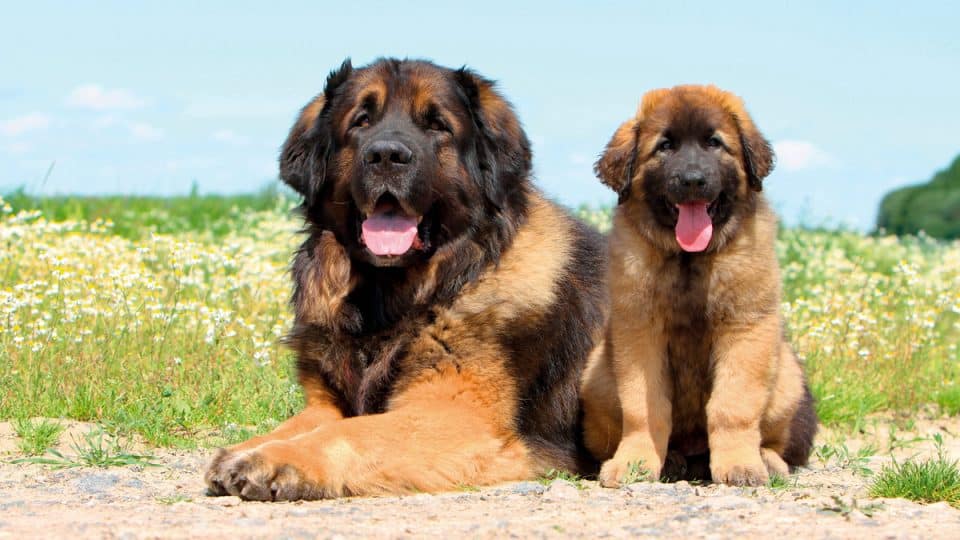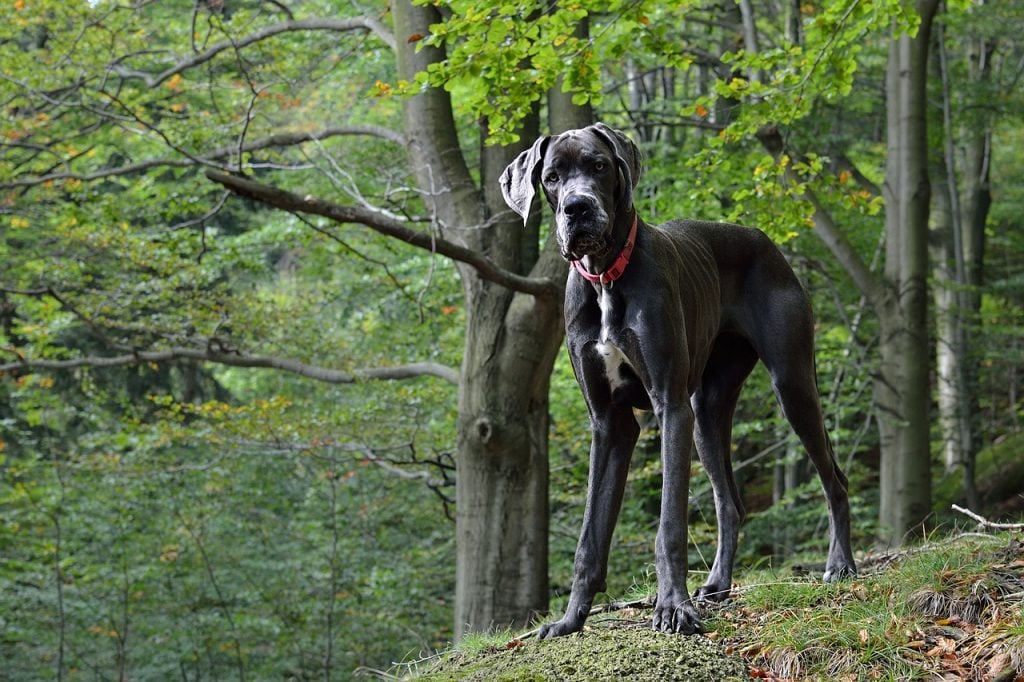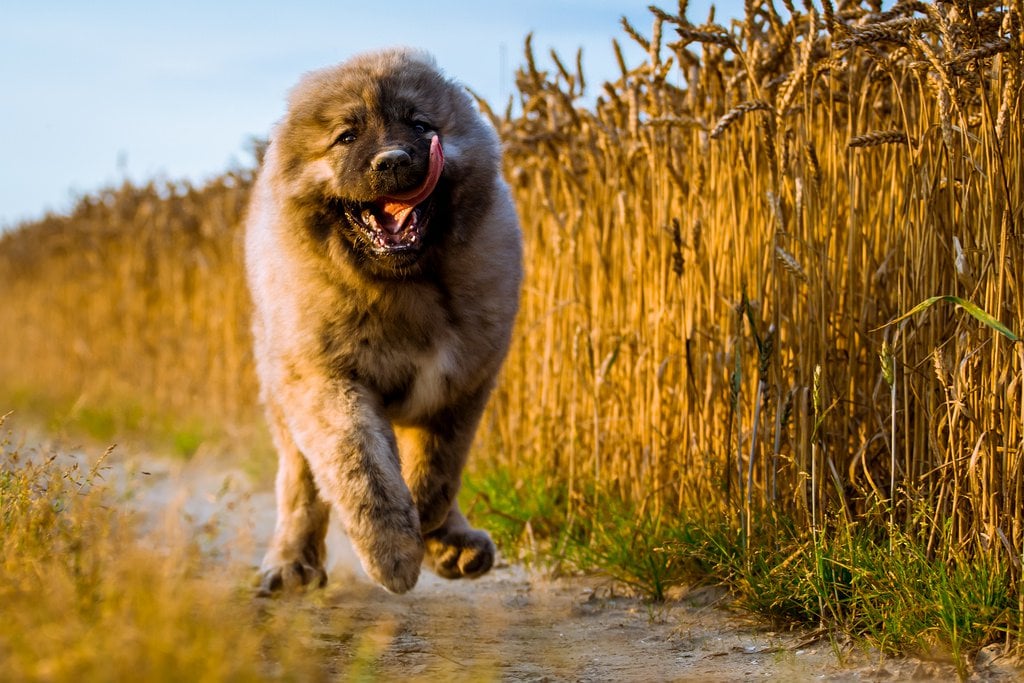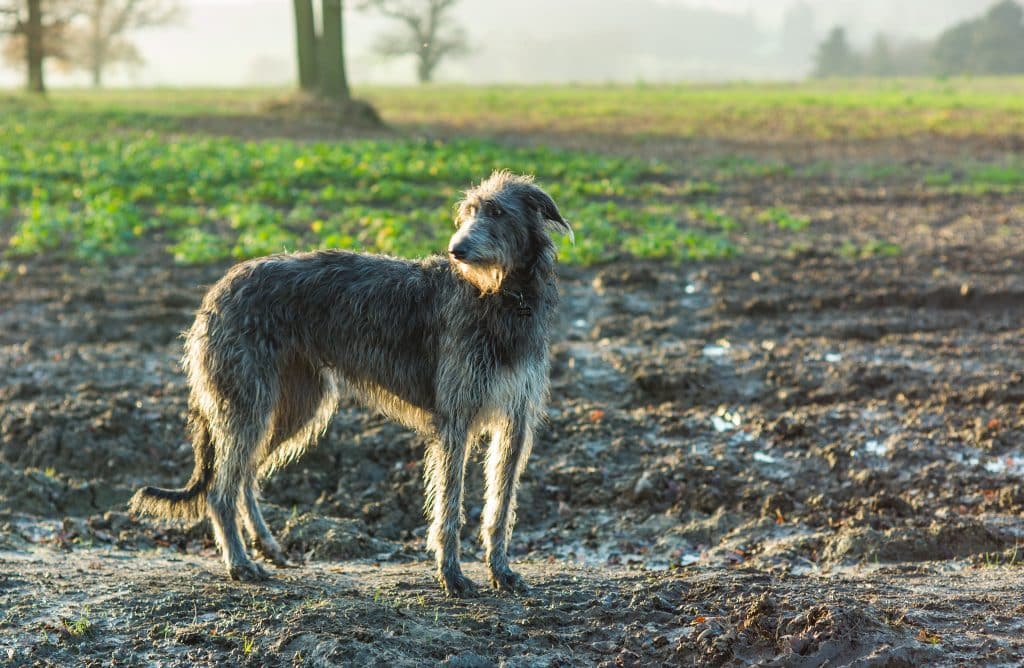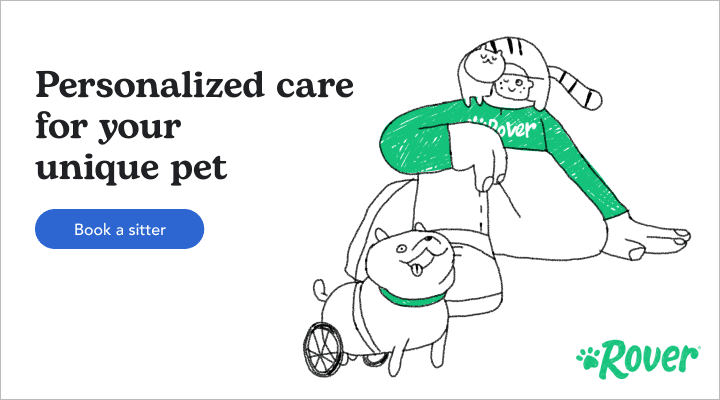Nothing beats cuddling up with your dog, and when they’re big—there’s even more to love. And despite their size, the largest dog breeds in the world can be among the gentlest, calm, and loving pets.
Generally speaking, a pooch within a healthy weight range for their breed that tips the scales over 55 lbs (25 kgs) would be considered a large dog breed. Meanwhile, those weighing 99 lbs (45 kgs) or more would be considered a giant dog breed.
So, which are the largest dog breeds recorded? The tallest ever dog, according to the Guinness World Records, is a Great Dane. Meanwhile, the largest and longest dog recorded was an Old English Mastiff. So, these can be considered the two biggest dog breeds in the world. But the Irish Wolfhound can often be bigger than the Great Dane in terms of height.
Read on for more about these gentle giants and which other dogs sit on the largest dog breeds in the world list.
English Mastiff
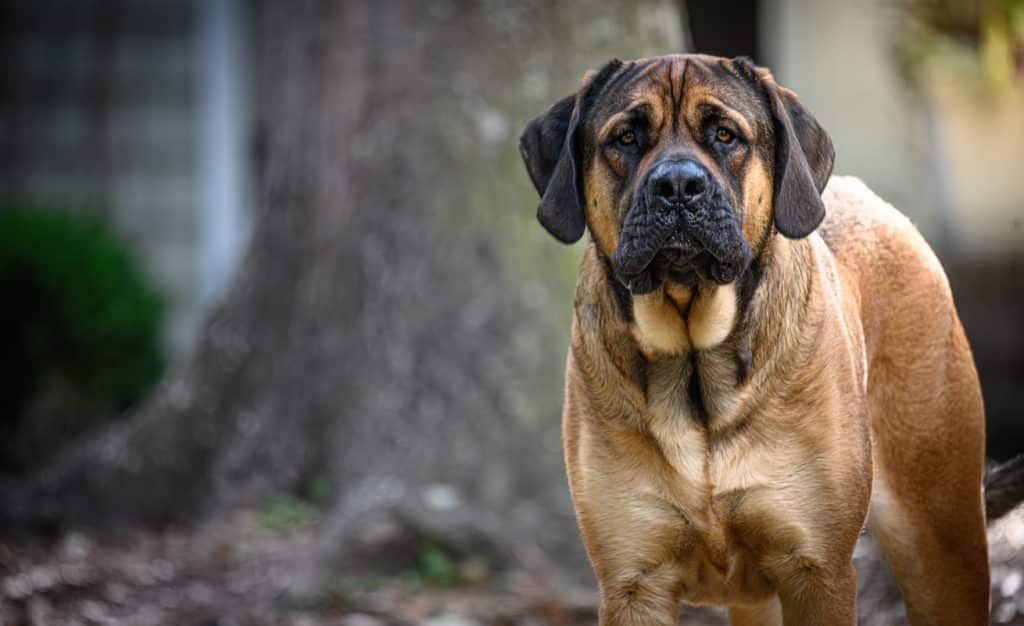
Darwin Brandis via iStock
Male Mastiffs can stand up to 30 inches at the shoulder, and can weigh as much as a full-grown human! Often, the English Mastiff—just referred to as the Mastiff by the American Kennel Club—is considered the largest dog breed by weight. It’s an ancient breed used in medieval England as big-game hunters, guardians, and war dogs. Mastiffs have since become more of a family dog, though they remain alert to what’s going on around them (with only a little slobber on the side).
- Weight: 120 to 170 pounds (female) or 160 to 230 (male)
- Height: 27.5 inches and over (female) or 30 inches and over (male)
- Personality: Docile, dignified and protective
- Grooming needs: Weekly, plus cleaning of skin folds around face
- Activity needs: Up to an hour per day, including walks and play
- Trainability: Average
- Barking: Low tendency
- Maturation: Two to three years
- Potential health issues (if any): Responsible breeders screen for health conditions such as eye anomalies, heart disease and hip dysplasia, von Willebrand’s disease, degenerative myelopathy, and epilepsy. Bloat is also a risk due to the English Mastiff’s large build and deep chest.
- How much space they need: A home or apartment with plenty of space and a yard recommended
- Life expectancy: Six to 10 years
Saint Bernard
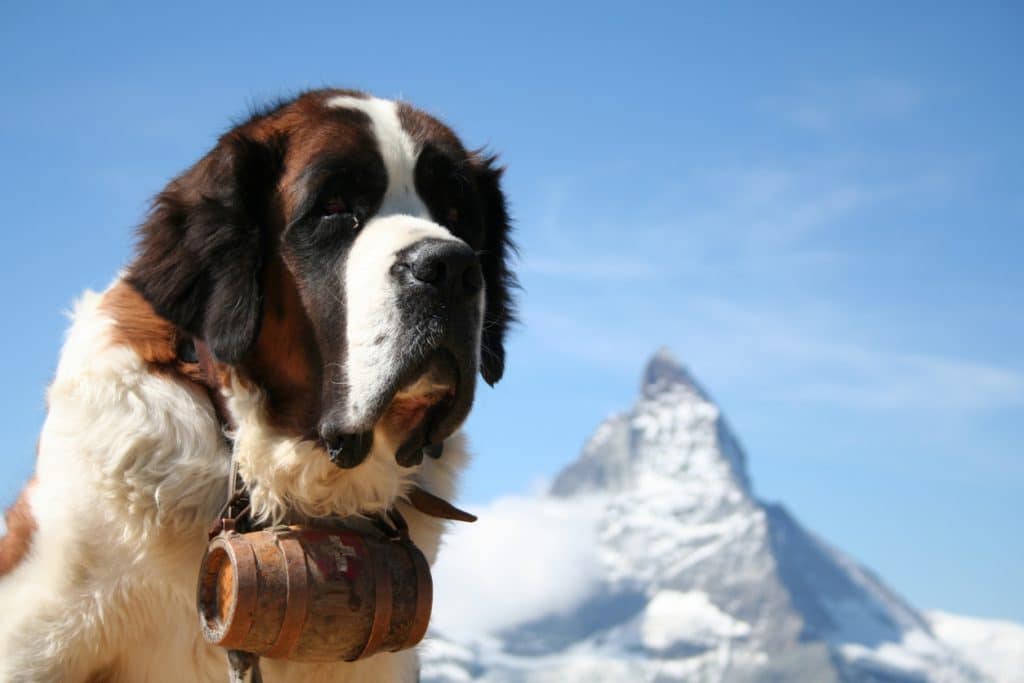
emmepiphoto via iStock
When you picture giant dog breeds, you may very well be visualizing a shaggy Saint Bernard! Everyone can appreciate the charming and playful nature of the Saint Bernard. Endlessly patient, they’re considered “nanny dogs” for children, and they adore every moment they spend with their loved ones. This breed was originally used to seek out and rescue lost travelers in the Swiss Alps, which makes sense considering their strength and size. Always keep these dogs in cool or air-conditioned spaces because they’re sensitive to heat.
- Weight: 120-140 lbs (female) or 140-180 lbs (male)
- Height: 26-28 inches (female) to 28-30 inches (males)
- Personality: Affectionate, family-orientated
- Grooming needs: Weekly (or daily during shedding season)
- Activity needs: At least an hour of exercise needed a day
- Trainability: Average
- Barking: Low tendency
- Maturation: Two to three years
- Potential health issues (if any): Can be susceptible to bloat, hip dysplasia and eye disease
- How much space they need: Plenty of space to move around indoors and outdoors
- Life expectancy: Eight to 10 years
Neapolitan Mastiff
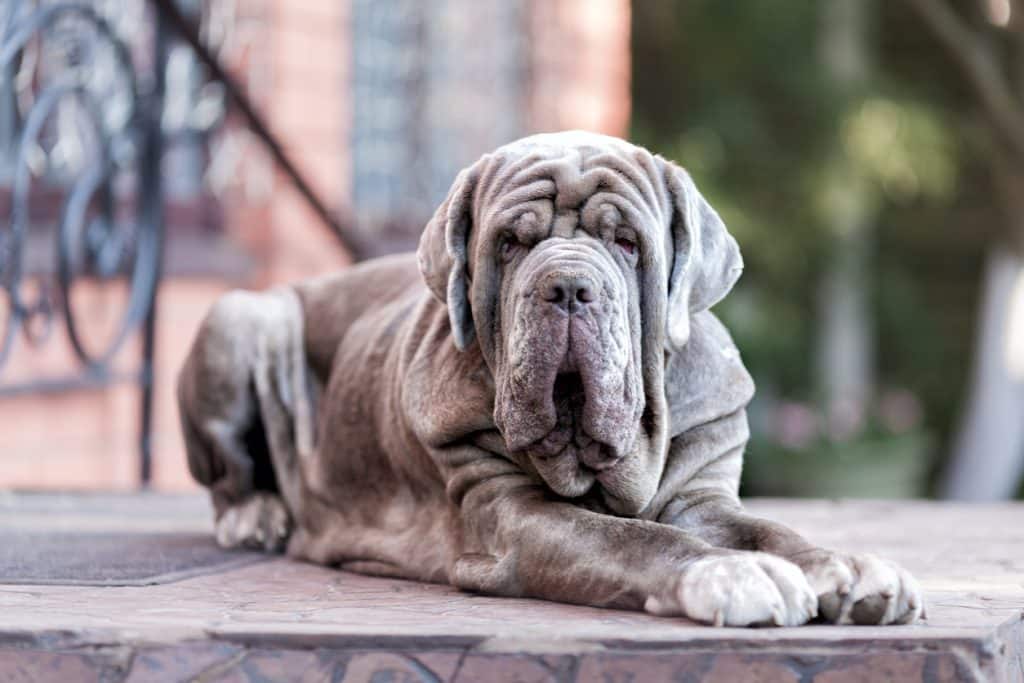
Salima Senyavskaya via iStock
With that unmistakable wrinkly face, the Neapolitan Mastiff—also known as the Mastino—is a powerful, loyal watchdog but a placid companion among loved ones. The breed may go as far back as 700 BC and they are thought to have been used as war dogs by the Roman Empire. With their large build and excess skin, the Neapolitan Mastiff can easily overheat so pet parents need to keep their eyes on them in warm weather.
- Weight: 110 lbs (female) or 150 lbs (male)
- Height: 24 to 29 inches (female) 26 to 31 inches (male)
- Personality: Loyal guardian, steady and sweet
- Grooming needs: Occasional
- Activity needs: Around an hour of exercise needed per day
- Trainability: Average
- Barking: Low tendency
- Maturation: Around 18 months
- Potential health issues (if any): Generally healthy but can be susceptible to cherry eye, bloat, back problems and hip dysplasia
- How much space they need: Home with a yard is ideal
- Life expectancy: Seven to nine years
Irish Wolfhound
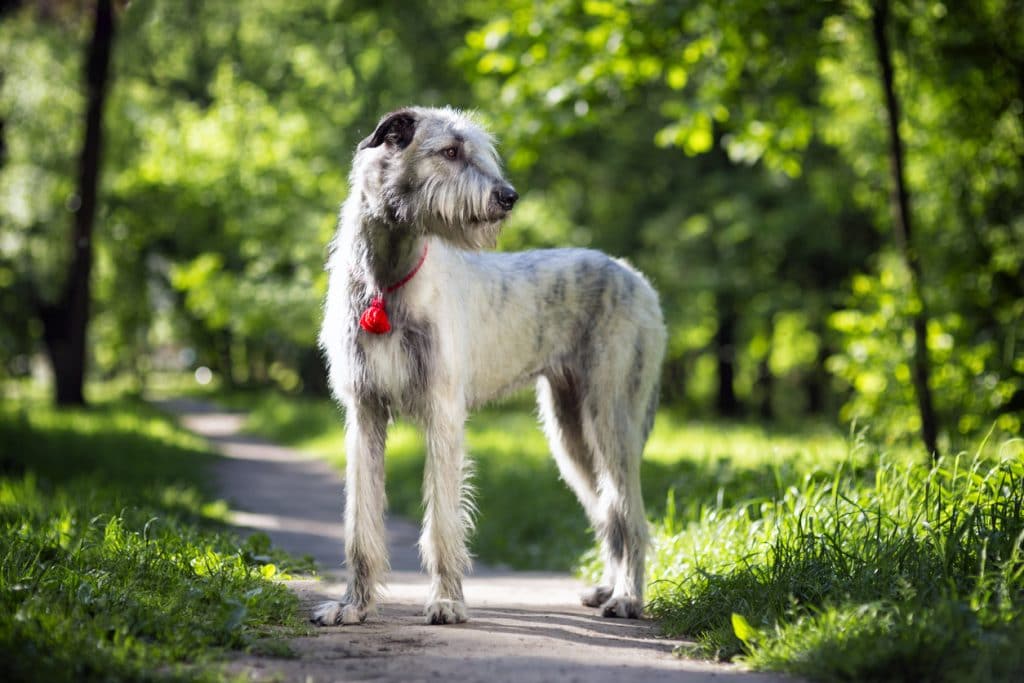
iStock/Laures
As the tallest dog breed (according to the American Kennel Club), the Irish Wolfhound make some of the sweetest, most amiable companions around. You would never guess that they were once bred to be ferocious war dogs, considering their gentle manner with children and other animals. Make sure to walk them regularly though—it will keep them in tip-top shape.
- Weight: 105 lbs (female) to 120 pounds (male)
- Height: A minimum of 30 inches (female) to 32 inches (male)
- Personality: Calm, patient and dignified
- Grooming needs: Weekly
- Activity needs: More than two hours per day
- Trainability: Average
- Barking: Low tendency
- Maturation: 18 months or more
- Potential health issues (if any): Susceptible to bloat. Heart and joint conditions can be hereditary but risk can be minimized with thorough screening by breeders.
- How much space they need: A home with a large fenced area is ideal
- Life expectancy: Six to eight years
Newfoundland
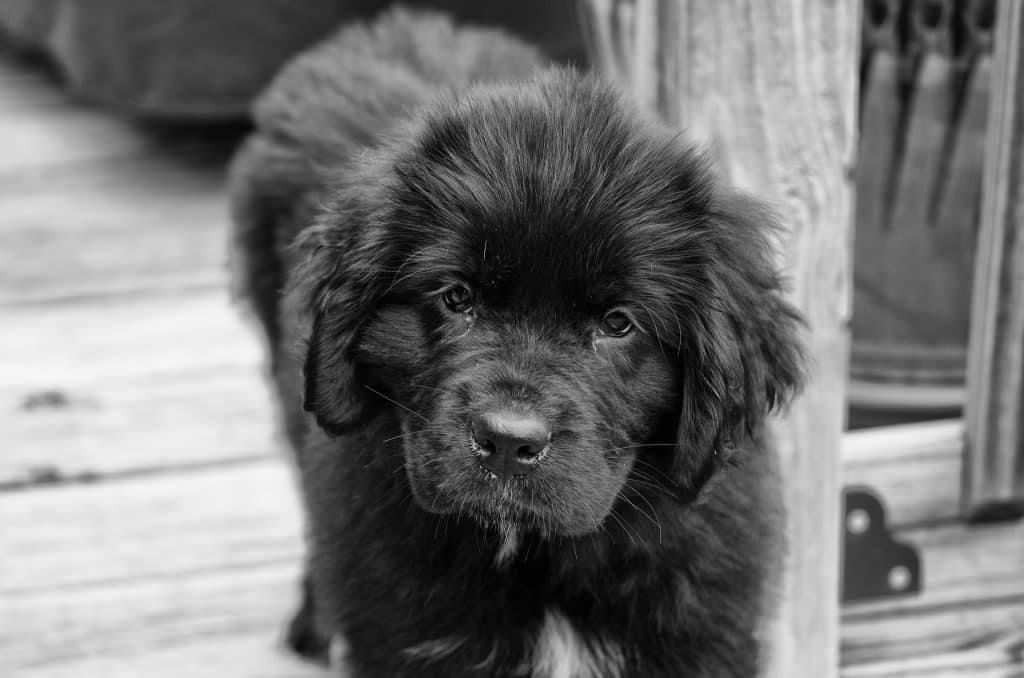
Flickr/Justin Noles
- Weight: 100 to 120 lbs (female) or 130 to 150 lbs (male)
- Height: Around 26 inches (female) or 28 inches (male)
- Personality: Sociable, affectionate and devoted
- Grooming needs: At least once a week
- Activity needs: Around an hour of exercise per day needed. Even better if this includes swimming!
- Trainability: Average
- Barking: Low tendency
- Maturation: Up to two years
- Potential health issues (if any): Can be prone to hip, elbow and cardiac issues as well as cystinuria, and responsible breeders screen for these conditions. Osteosarcoma, atopy (allergies), hypothyroidism, panosteitis (bone disease) and eyelid problems can also be a risk.
- How much space they need: A home with yard space and ideally near water for swimming
- Life expectancy: Nine to 10 years
Dogue de Bordeaux (French Mastiff)
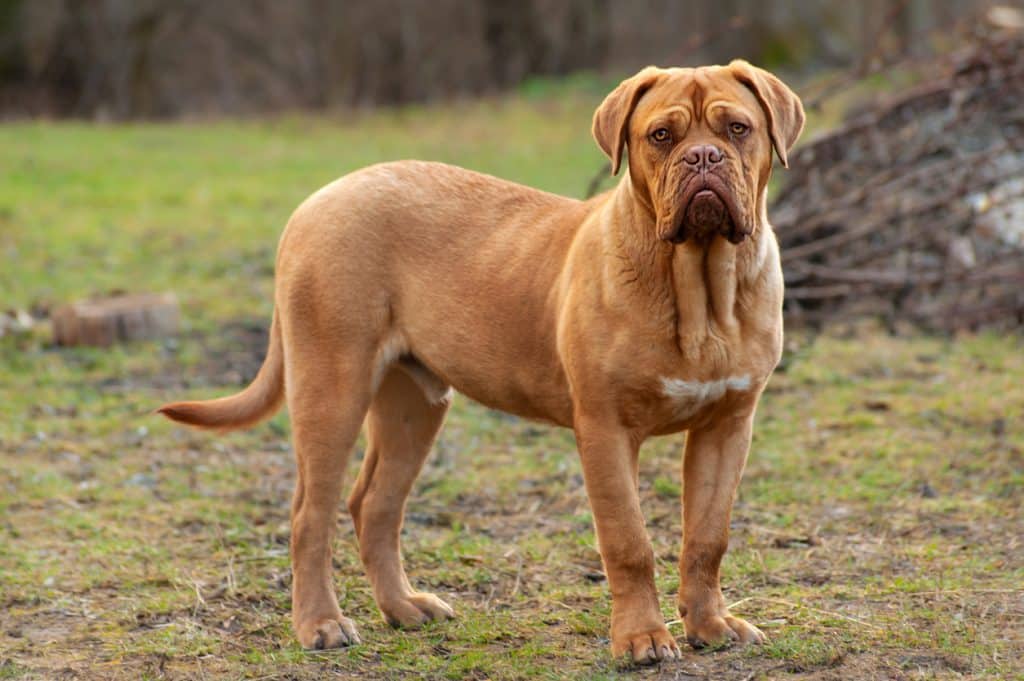
Denys Rzhanov via iStock
The Dogue de Bordeaux breed is incredibly powerful and can weigh in at almost 110 pounds. Though their heads are huge (in fact, they’re the largest in the canine kingdom), their kind eyes and furrowed brows make them seem approachable and sweet. They are indeed loyal and loving to their family, but they definitely require training to tame their stubbornness.
- Weight: 99 lbs and upwards (female) or 110 pounds and up (male)
- Height: 23-26 inches (female) or 23.27 inches (male)
- Personality: Loyal, affectionate and sensitive
- Grooming needs: Weekly
- Activity needs: At least an hour’s walk per day is needed, on top of playtime
- Trainability: Easy
- Barking: Medium tendency
- Maturation: Around 18 months
- Potential health issues (if any): At high risk of bloat. Other health conditions affecting the breed can include heart disease, hip and elbow problems and epilepsy
- How much space they need: A home with plenty of indoor and outdoor space is ideal, but they can adapt to apartment living
- Life expectancy: Five to eight years
Leonberger
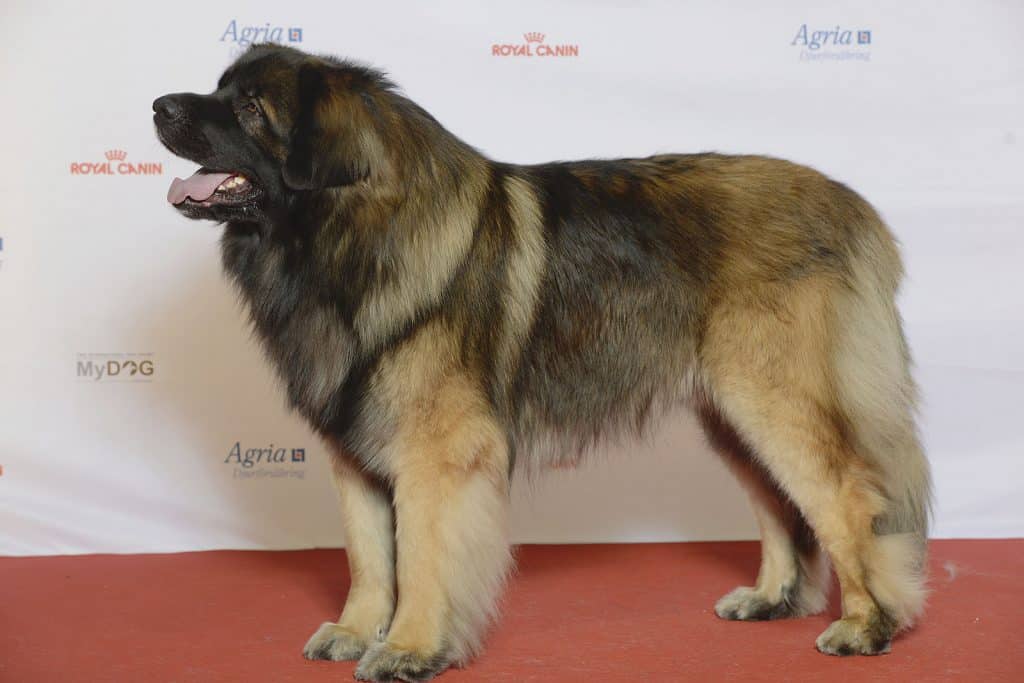
Flicker@SvenskaMassen
Leonbergers were developed in Germany to be companions—in fact, Napolean III, Tsar Alendar II, and the Prince of Wales (later King Edward VII) all welcomed this breed into their homes. And with their gentle nature, patience and elegance, it’s clear why they’re popular additions to many families. But don’t let their friendliness fool you, Leonbergers make excellent watchdogs and are hard workers—whether they’re working on farms or romping around.
- Weight: 90 to 140 lbs (female) or 110 to 170 lbs (male)
- Height: 25.5-29.5 inches (female) or 28-31.5 inches (male)
- Personality: Loving, gentle and patient
- Grooming needs: Daily
- Activity needs: Two hours of exercise needed per day
- Trainability: Easy
- Barking: Medium tendency
- Maturation: One year
- Potential health issues (if any): Hip dysplasia and bloat a risk in the breed
- How much space they need: Adaptable to apartment living but homes with a large yard are best
- Life expectancy: Seven years
Anatolian Shepherd
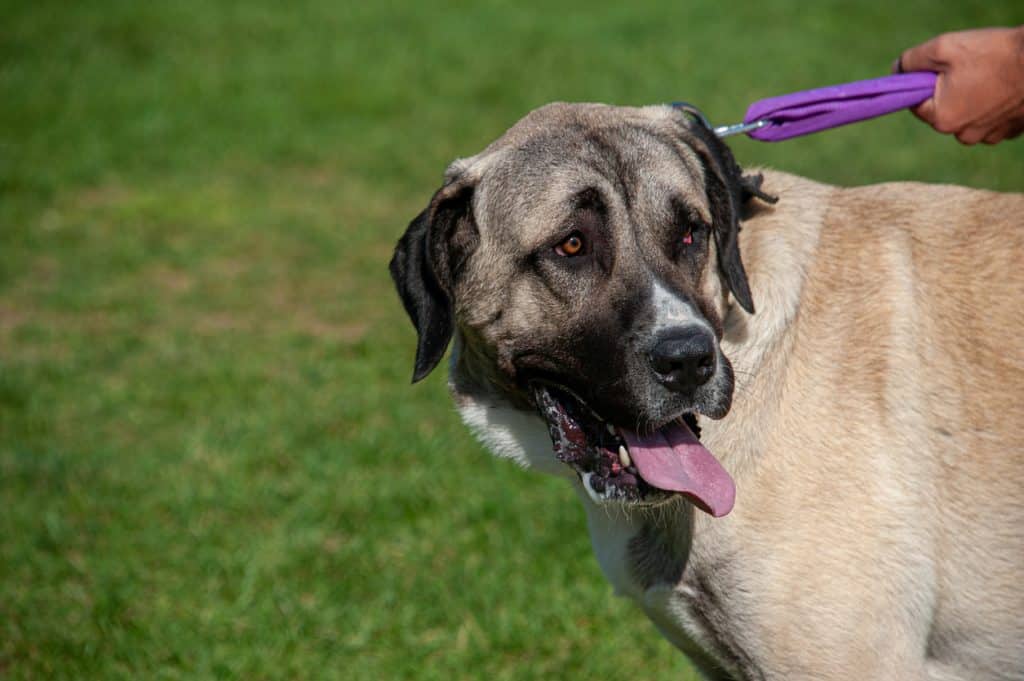
fikretozk via iStock
An ancient breed, Anatolians (or some variation of them) are believed to be referenced in some of the earliest books of the Bible. This breed is smart and insanely protective of the people they love—which means they need a leader who can handle a strong and dominating personality. Weighing up to 150 pounds, many of these dogs are still working ranch dogs.
- Weight: 80-120 pounds (female) to 110-150 pounds (male)
- Height: 27 inches (female) to 29 inches (male)
- Personality: Independent, protective and intelligent
- Grooming needs: Weekly (more during shedding season)
- Activity needs: Up to two hours exercise needed per day
- Trainability: Hard to medium
- Barking: Medium tendency
- Maturation: Two years or more
- Potential health issues (if any): An overall healthy breed with limited health conditions, but screening for hip and elbow issues is recommended.
- How much space they need: A home with a large yard recommended
- Life expectancy: 11 to 13 years
Central Asian Shepherd Dog
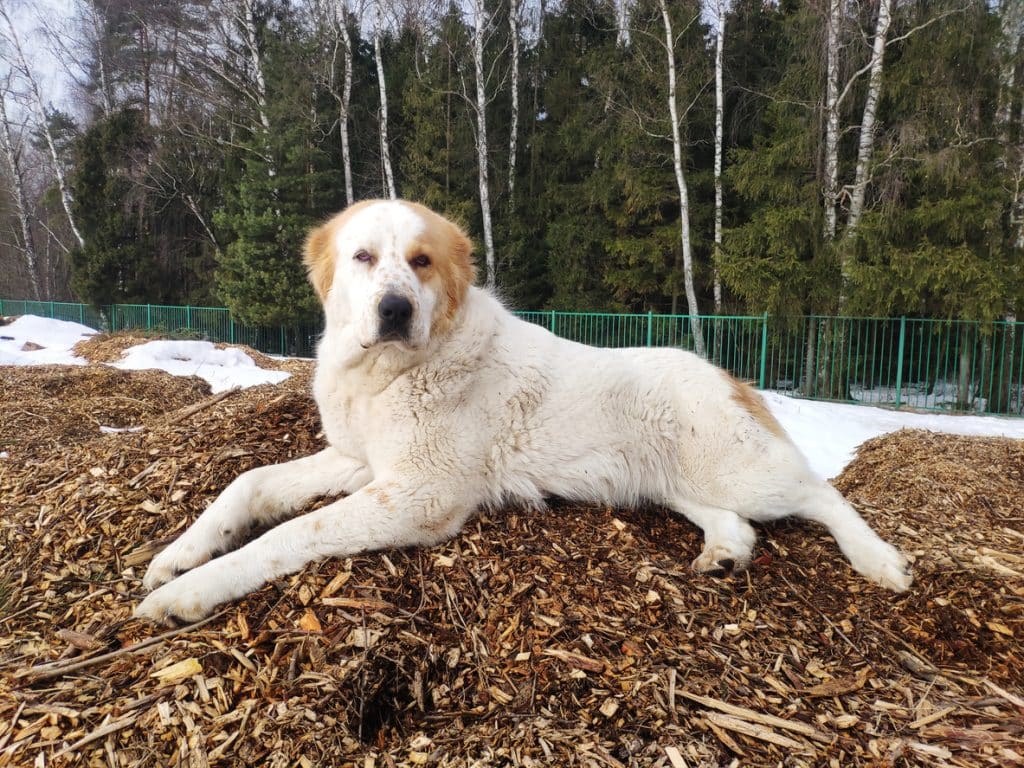
Anna Kanishcheva via iStock
A rare sight outside of its namesake continent, the majestic Central Asian Shepherd Dog—also known as the Alabai—is a livestock guardian dog breed steeped in history. And that history dates back more than 4,000 years when the breed was formed from natural selection. They’re a fearless, protective breed, so only for experienced dog parents, but can be loyal and loving in the right home.
- Weight: 88 to 110 pounds
- Height: 25.5 to 27.5 inches
- Personality: Independent, intelligent and protective
- Grooming needs: Weekly
- Activity needs: At least an hour of exercise per day needed
- Trainability: Average
- Barking: Medium tendency
- Maturation: One to two years
- Potential health issues (if any): Generally healthy, with less hereditary diseases compared to many other breeds. Screening for hip dysplasia is still recommended.
- How much space they need: A home with a large yard is recommended
- Life expectancy: 12 to 15 years
Great Dane
- Weight: 110 to 140 lbs (female) or 140 to 175 lbs (male)
- Height: 28 to 30 inches (female) 30 to 32 inches (male)
- Personality: Affectionate, dependable and easygoing
- Grooming needs: Weekly
- Activity needs: A minimum of two hours of exercise a day (ideally over two to three walks)
- Trainability: Average
- Barking: Medium tendency
- Maturation: 18 months to two years
- Potential health issues (if any): Bloat is the number one killer of Great Danes, with some owners considering preventative surgery. Other health issues include eye and cardiac diseases, hypothyroidism and autoimmune thyroiditis, and hip dysplasia. Responsible breeders screen for these conditions, which can minimize but not eliminate risk.
- How much space they need: A home with secure outdoor space
- Life expectancy: Seven to 10 years
Caucasian Shepherd Dog
One of the most striking of the giant dog breeds, the Caucasian Shepherd Dog is known to be an incredible guardian—which means they require an experienced owner to balance out that stubbornness and intensity. They were bred to hunt bears in the mountains of Russia, and you know what? They resemble a bear, just a bit. This breed has been around nearly 600 years and can weigh up to 200 pounds. They’re active and hardworking and need plenty of activity and training.
- Weight: 99 to 170 pounds
- Height: 23 to 30 inches
- Personality: Protective, bold and kind
- Grooming needs: Daily if long-haired, weekly if short
- Activity needs: Up to one hour exercise per day needed
- Trainability: Average
- Barking: Medium to low tendency
- Maturation: Two to three years
- Potential health issues (if any): None listed
- How much space they need: Ideally a home with a large yard
- Life expectancy: 10 to 12 years
Cane Corso (Italian Mastiff)
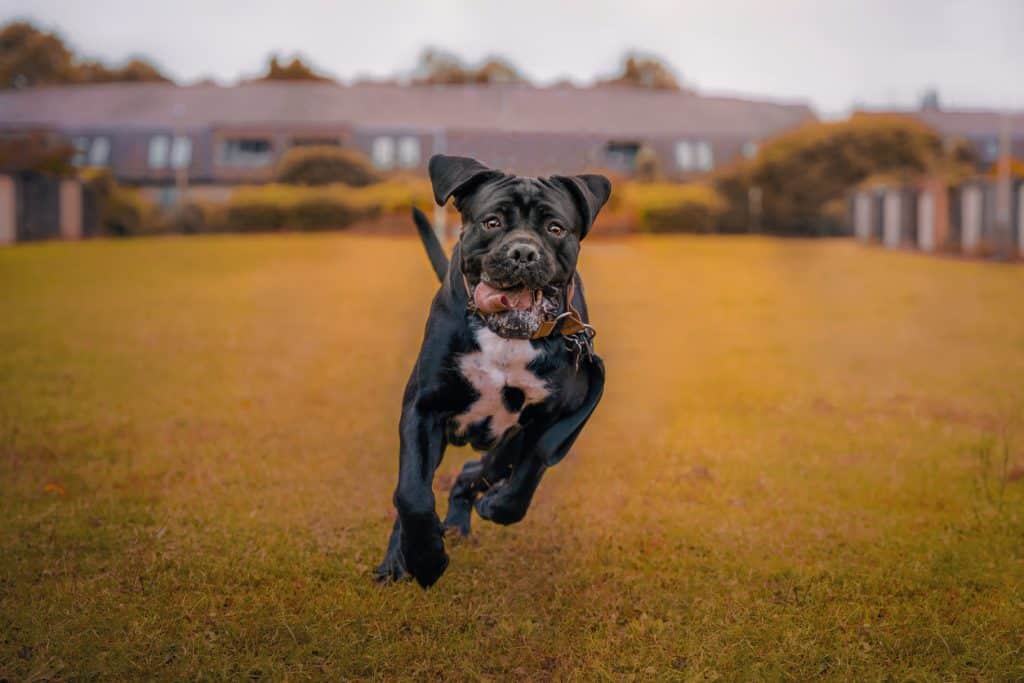
Szabina Hercz via iStock
With a lineage that goes back to ancient Roman times, this giant dog breed is known for their excellence as guardians. Always alert and confident, Cane Corsos are very loyal to their humans. And the fact that they weigh over 100 pounds and have lots of muscles makes them intimidating to any would-be intruders.
- Weight: 90 to 110 lbs
- Height: 23.5-26 inches (female) or 25-27.5 inches (male)
- Personality: Clever, affectionate and energetic
- Grooming needs: Weekly
- Activity needs: At least two hours exercise per day, including off lead
- Trainability: Easy
- Barking: Medium tendency
- Maturation: Up to two years
- Potential health issues (if any): Susceptible to bloat but generally healthy if genetic health testing for conditions like hip dysplasia and idiopathic epilepsy is carried out by breeders
- How much space they need: Homes with a large secure yard ideal
- Life expectancy: Nine to 12 years
Great Pyrenees

flickr/aikos
- Weight: 85 pounds and up (female) or 100 pounds and up (male)
- Height: 25-29 inches (female) or 27-32 inches (male)
- Personality: Smart, calm and affectionate
- Grooming needs: Weekly
- Activity needs: Up to an hour of exercise per day
- Trainability: Average
- Barking: Medium tendency
- Maturation: One to two years
- Potential health issues (if any): Responsible breeders screen for elbow and hip dysplasia, eye disorders, luxating patellas, and neurological and immune-mediated disorders. Bloat is also a risk.
- How much space they need: Happiest with a large yard to run around in, but can adapt to spacious apartment life
- Life expectancy: 10 to 12 years
Greater Swiss Mountain Dog
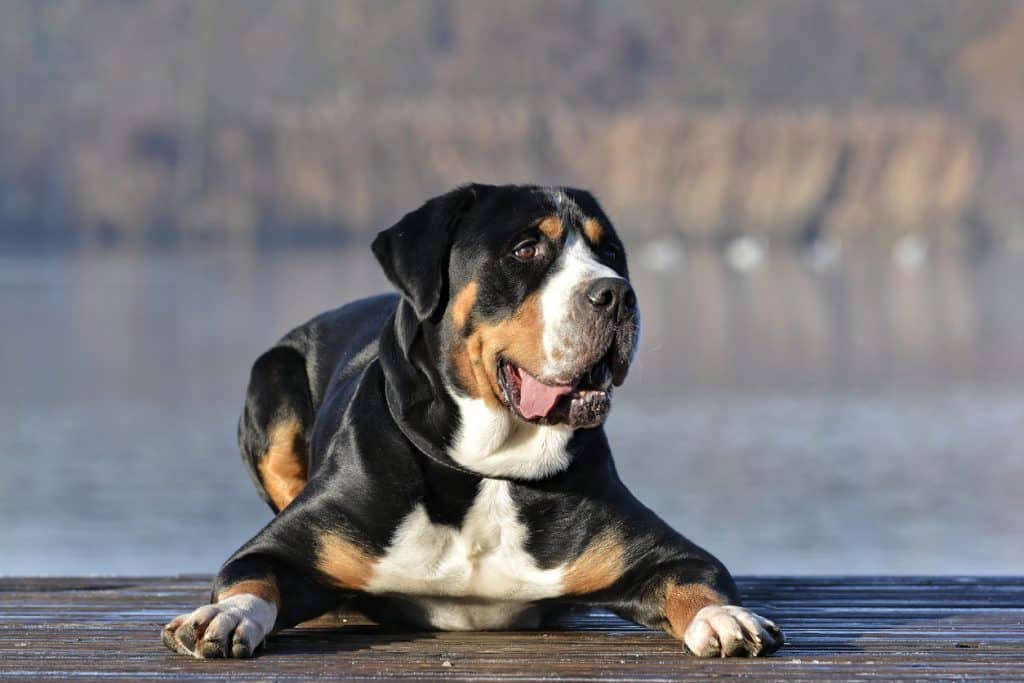
Anzze86 via iStock
Known as “Swissies” to their admirers, these dogs were originally bred to herd cattle and serve as watchdogs—and they still love jobs. It’s best to not keep them cooped up in an apartment since they need some room to wander. They also have a deep bark (which close neighbors may not love), but at heart, they’re gentle and loving. Just be sure to train and socialize them early, and prepare yourself for a puppyhood that lasts for a while as this breed is a little slow to mature.
- Weight: 85 to 110 pounds (female) to 115 to 140 pounds (male)
- Height: 23.7 to 27 inches (female) or 25.5 to 28.5 inches (male)
- Personality: Affectionate, faithful and active
- Grooming needs: Occasional
- Activity needs: Up to one hour of exercise needed per day
- Trainability: Average to easy
- Barking: Medium tendency
- Maturation: Around 18 months
- Potential health issues (if any): Generally a healthy breed but prone to conditions such as bloat and splenic torsion
- How much space they need: Best suited to homes with large fenced yards
- Life expectancy: Eight to 11 years
Komondor
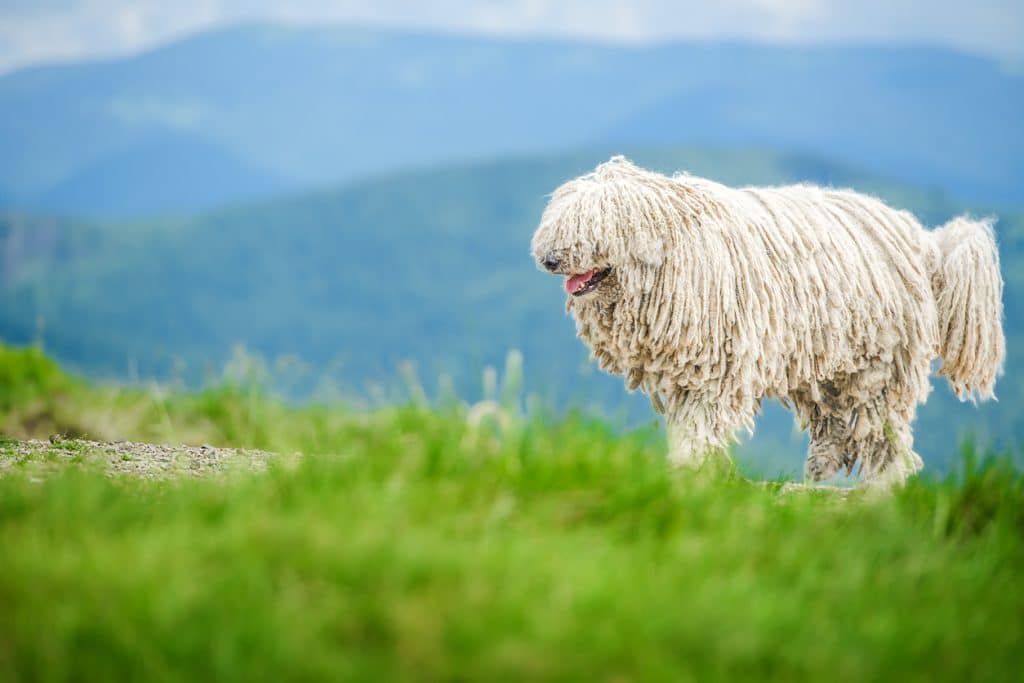
Zelenenka via iStock
via flickr/petful
It’s hard not to notice this breed, with the signature white coils of their coats that offer them protection in extreme weather. Long used as guardians for sheep, these dogs sport dreadlocks to keep them well hidden among the herd, so they can surprise any unexpected visitors. Loving and loyal to family members, these canines are very independent and need a firm, consistent person to train and care for them. They’re one of the largest dog breeds that don’t shed, or shed very little. This also makes Komondors one of the largest hypoallergenic dog breeds.
- Weight: 80 pounds or more (female) or 100 pounds or more (male)
- Height: 25.5 minimum inches (female) to 27.5 minimum inches (male)
- Personality: Dignified, devoted and loving
- Grooming needs: More than once a week
- Activity needs: Up to one hour of exercise needed per day, including secure off lead time (dog parks not recommended)
- Trainability: Average to easy
- Barking: Medium tendency
- Maturation: 18 months to two years
- Potential health issues (if any): Can be prone to hip dysplasia, eye problems and bloat
- How much space they need: Best suited to a rural home with a large fenced yard
- Life expectancy: 10 to 12 years
Black Russian Terrier
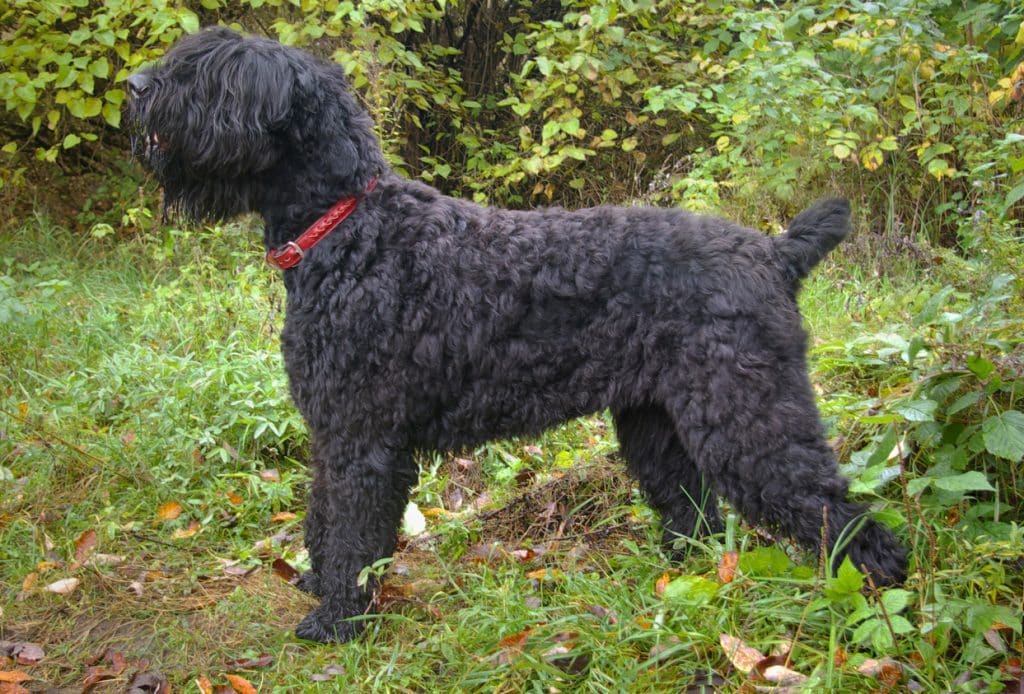
Alazor via iStock
- Weight: 80 to 130 pounds
- Height: 26 to 29 inches (female) or 27 to30 inches (male)
- Personality: Loyal, energetic and protective
- Grooming needs: Twice weekly
- Activity needs: At least 30 to 40 minutes of exercise needed per day
- Trainability: Average to easy
- Barking: Medium tendency
- Maturation: Up to three years
- Potential health issues (if any): Responsible breeders will screen for heart problems, allergies, urinary tract stones, hip and elbow dysplasia, and progressive retinal atrophy
- How much space they need: Plenty of space to move around indoors, ideally with access to a secure yard. But can adapt to apartment living.
- Life expectancy: 10 to 12 years
Scottish Deerhound
adamnsinger via FLICKR
This super rare breed goes way back, and is often called the “Royal Dog of Scotland”. Scottish Deerhounds are one of the tallest breeds, and though their size can be intimidating, they’re actually friendly and sweet—which (aside from their size) doesn’t make them the best guard dogs. Deerhounds are super active puppies, but they tend to mellow out as they grow older. Just don’t forget to keep up with their daily walks to ensure they stay healthy.
- Weight: 75 to 95 lbs (female) or 85 to 110 lbs (male)
- Height: More than 28 inches (female) or 30-32 inches (male)
- Personality: Gentle, dignified and loving
- Grooming needs: Weekly to fortnightly
- Activity needs: More than two hours of exercise needed a day including off-lead running
- Trainability: Average
- Barking: Low tendency
- Maturation: One to two years
- Potential health issues (if any): A generally healthy breed but reported issues include osteosarcoma, dilated cardiomyopathy, cystinuria, bloat and surgery-related problems
- How much space they need: A home with a large fenced outdoor area is recommended
- Life expectancy: Eight to 11 years
Akita
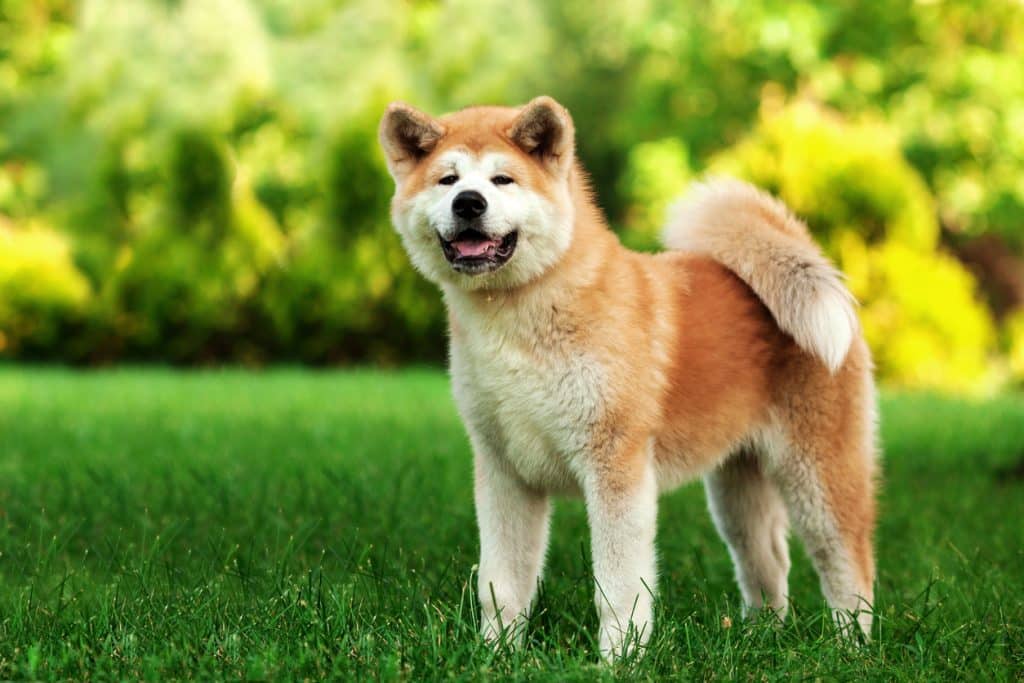
TaynaPanova via iStock
As giant dog breeds go, Akitas are on the smaller end, though still quite large. Akitas are of ancient Japanese lineage and for centuries have occupied a special place in Japanese culture—in fact, Hachiko, an Akita from the 1920s, is among Japan’s most cherished symbols. Though they tend to be wary of strangers, this breed is loyal and affectionate when it comes to their loved ones and celebrated for courage and loyalty. Just make sure to socialize them from an early age to keep their stubbornness in check.
- Weight: 70 to 100 pounds (female) to 100 to 130 pounds (male)
- Height: 24 to 26 inches (female) or 26-28 inches (male)
- Personality: Loyal, clever and independent
- Grooming needs: Weekly
- Activity needs: Up to two hours exercise needed per day
- Trainability: Average
- Barking: Low to medium tendency
- Maturation: 10 months to one year
- Potential health issues (if any): Susceptible to bloat and screening is recommended for eye and thyroid disorders and hip dysplasia
- How much space they need: Best suited to homes with a large yard
- Life expectancy: 10 to 14 years
Bernese Mountain Dog
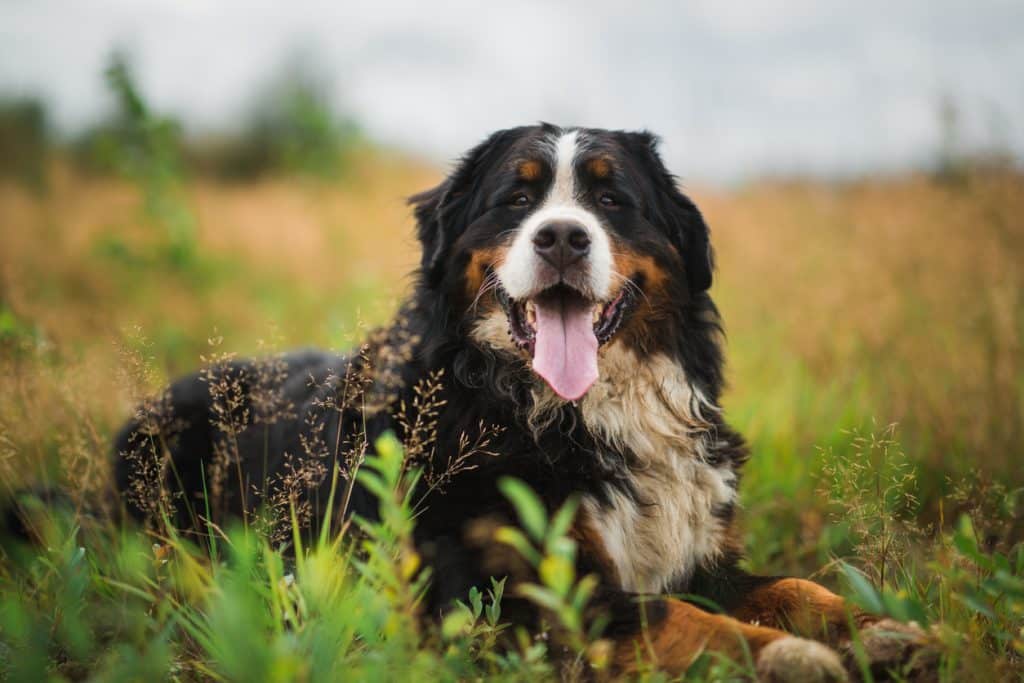
iStock/Aleksandr Zotov
So sweet and affectionate, the Bernese Mountain Dog is often considered one of the most beautiful breeds around. These dogs have thick and silky coats that are colored black, white and rust. But those coats aren’t just for looks, they’re also perfect for keeping them cozy in cold weather. Though they enjoy getting outside for exercise, they also relish opportunities to hang out with the family.
- Weight: 70 to 95 lbs (female) or 80-115 lbs (male)
- Height: 23-26 inches (female) or 25-27.5 inches (male)
- Personality: Soppy, loving, and highly intelligent all-found family dog
- Grooming needs: More than once a week
- Activity needs: Need up to one hour of exercise per day
- Trainability: Easy
- Barking: Medium tendency
- Maturation: Up to two years
- Potential health issues (if any): Generally healthy, but susceptible to bloat. Screening for hip and elbow dysplasia, blood disorders, some cancers, and progressive retinal atrophy is recommended.
- How much space they need: A home with large garden recommended
- Life expectancy: Seven to 10 years
Giant Dog Breeds as Family Pets
For those who are ready to bring a big dog into their home, any of these beautiful giant breeds would make an incredible addition to the family. Though their sheer size gives an intimidating first impression, many of these canines are good-tempered, loyal, and loving. These giant dog breeds are typically more relaxed than their smaller counterparts and fairly calm at home, with short bursts of energy. But those bred for work and protection need strong training and good socialization to harness those instincts.
Dr. Ellen Russell, DVM, MPH, vet expert for the Malamute Mom, says: “Large dog breeds can make great family pets due to their friendly and loyal personalities. They tend to be gentle, loving, and affectionate with children. These big dogs are also very intelligent and eager to please, making them easy to train for basic obedience commands or even more sophisticated behaviors. Large breeds generally require plenty of exercise and attention, so they may not be the best choice for individuals with busy lifestyles. However, if provided with enough exercise and stimulation, they can be very loyal and devoted companions.”
Sadly, though, life spans among many of the breeds on this list are shorter than those of many smaller dogs due to their size and development rate, explains Dr. Russell. “These breeds grow faster than smaller breeds, which puts more strain on their bodies and can lead to complications or health issues that may shorten their lifespan,” she says.
“Additionally, large-breed dogs often suffer from orthopedic issues due to their size and build, such as hip dysplasia or arthritis. This could really take a toll on the dog’s health and possibly lead to a shorter life expectancy.”
Takeaway
Dr. Russell explains that answering the question ‘what is the biggest dog in the whole world?’ is “highly subjective” and depends on individual dogs and factors such as height and weight.
She says that there is not one single giant breed that’s the biggest, as it can be down to individual dogs. While the Great Dane is often referred to as the world’s biggest breed, she explains that others – like the Neapolitan Mastiff – can be the same size if not larger. And other breeds, like the Irish Wolfhound, can be taller than other giant breeds, despite weighing less.
What’s not to love about these giant breeds? As long as you have the space, time and finances to devote to caring for one of the dogs on this list, they’ll make wonderful companions.
